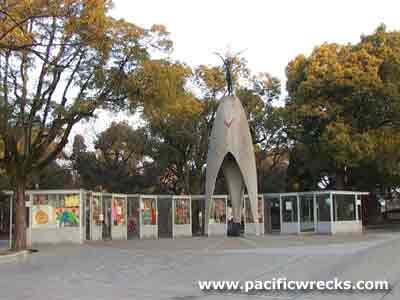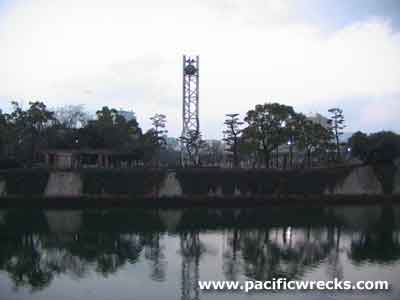|
|
|
| Missing In Action (MIA) | Prisoners Of War (POW) | Unexploded Ordnance (UXO) |
| Chronology | Locations | Aircraft | Ships | Submit Info | How You Can Help | Donate |
|
 USAAF August 6, 1945  Justin Taylan 2003  Justin Taylan 2003     Justin Taylan 2003  Shigeaki Mori 1999 |
Location Lat 34° 23' 60N Long 132° 26' 60E Hiroshima 広島市 is located at an elevation of 85' / 25m above sea level and is the capital of Hiroshima Prefecture in the Chūgoku Region on the south coast of Honshū in Japan. Also known as Hiroshima Shi (Hiroshima City). Borders Ujina Harbor and Hiroshima Bay to the south that and beyond Kure Harbor and the Inland Sea. Wartime History Hiroshima was an industrial city and based Imperial Japanese Army (IJA) units including the 2nd Army under the command of Field Marshal Shunroku Hata with the headquarters at Hiroshima Jo (Hiroshima Castle) tasked with the defense of southern Japan. Also based the 59th Army, 5th Division and 224th Division. Hiroshima was defended by five During 1945, Hiroshima was not targeted by B-29 Superfortress bombing raids or fire bombings, aside from aerial mining of Hiroshima Bay and U.S. Navy carrier aircraft attacks against shipping. Despite the lack of bombing raids, the Japanese demolishing structures to create firebreaks to limit damage as a defensive measure against fire bombing. Towards the end of the Pacific War, the population of Hiroshima had begun to decrease as civilians were ordered to evacuate to the countryside. By early August 1945, the population of Hiroshima was estimated to be roughly 350,000 people. On August 6, 1945 a morning air raid warning was lifted at 7:31am and most Hiroshima residents had returned to their normal activities and were not sheltering in air raids or expecting an attack. At 8:15am B-29 "Enola Gay" 44-86292 at an altitude of 31,600' dropped the first atomic bomb nicknamed "Little Boy" aimed at the "T" shaped Aioi Bridge in Hiroshima. Fifty seconds later, the bomb missed the aiming point by 800' due to cross winds and exploded directly over Shima Surgical Clinic a location that was dubbed the hypocenter. The atomic bomb exploded causing a bright flash and explosion that released the energy of roughly 16 kilotons of TNT and caused a radius of destruction of roughly 1 mile with fires caused over a radius of 4.4 square miles and a mushroom cloud. On the ground, an estimated 70,000-80,000 people died instantly in the blast and firestorm with an equal number injured. Three hours later, a firestorm reached its peak causing a huge cloud of smoke. exploded at a location dubbed the hypocenter roughly 160 meters southeast of the Hiroshima Prefecture Industrial Promotion Hall (A-Bomb Dome). This was the first atomic weapon used in combat and released on a city. American missions against Hiroshima April 2, 1945–August 6, 1945 Aioi Bridge The Aioi Bridge is a "T" shaped bridge was used as the aiming point for the atomic bomb. It survived the blast, the new bridge is located in the same position and also has a "T" shape. Hiroshima Prefecture Industrial Promotion Hall (A-Bomb Dome) Designed by Czech architect Jan Letzel, and constructed in April 1915. Its green colored dome was well known the citizens of Hiroshima. The atomic bomb hypocenter was approximately 160 meters to the southeast of the building. The building was partially destroyed by the blast, but the frame of the dome and outer wall survived. Preserved as a monument, the building is one of the most well known symbols of the city and around the world. In December 1996, it became a UNESCO world heritage site. Hiroshima Castle 21-1 Motoi, Nake-ku Tel 082-221-7512 Built by feudal lord, Yerumoto Mori. During the war, the castle and grounds were occupied by the 2nd General Army HQ and 5th Army Division. It was completely destroyed by the atomic bomb, but 'faithfully rebuilt' in 1958. Today is a museum to display samurai artifacts. Hiroshima Peace Memorial 1-2 Nakajuna-cho, Naka-ku Tel 082-241-4004 Museum dedicated to the history of the atomic bomb. This modern museum has all displays in both Japanese and English and other languages. A scale model of the city shows the area before and after the bomb, as well as displays of artifacts, photographs and other information. It is an impressive museum in terms of both the impact of its presentation, and even handed depiction of the history. National Memorial Hall for A-bomb Deceased This impressive monument looks toward the A-Bomb Dome and an eternal flame. Cenotaph for A-Bomb Victims This arch provides a view from the Peace park to National Memorial Hall. Children's Peace Memorial Memorial at Hiroshima. Atomic Bomb Memorial Mound Memorial at Hiroshima. Memorial For U.S. POWs (Former Chugoku Kempei-Tai Headquarters) Installed during 1999 due to the efforts and personal funds of Hiroshima resident and A-bomb survivor, Shigeaki Mori. At least 12 American POWs were killed in the atomic bomb blast, while being detained at the Kempei-Tai (Military Police) Headquarters near the hypocenter. These POWs were from the crews of four American aircraft that went down in the area. Today, the former HQ, today an office building. Peace Bell Dedicated in 1964, this bell is to encourage world peace and end to nuclear weapons. Peace Clock Tower This clock tower chimes at 8:15am everyday, the moment when the atomic bomb exploded over the city. Donated by the Lions Club in 1967, for the goal of world peace. Korean Monument For Koreans killed in the blast. Ujina Harbor Used as a military port during the Sino-Japanese war. In 1940 a civilian industrial port opened as well, including filling 3.2 km of sea to create land. Mitsubishi Heavy Industries selected the site for a machine factory. In 1943, part this industrial area was also used by the Japanese Army Air Force (JAAF) airfield. The first wartime ship built at this location was Hisakawa Maru completed in 1944. B-24J "Lonesome Lady" Serial Number 44-40680 Pilot Carwright crashed July 28, 1945 at Ikachi village crew KIA / POW died in atomic bomb blast B-24J "Taloa" Serial Number 44-40716 Pilot Marvin crashed July 28, 1945 at Yawata near Hiroshima crew KIA / POW died in atomic bomb blast Contribute
Information Last Updated
|
Map Fallingrain |
| Discussion Forum | Daily Updates | Reviews | Museums | Interviews & Oral Histories |
|